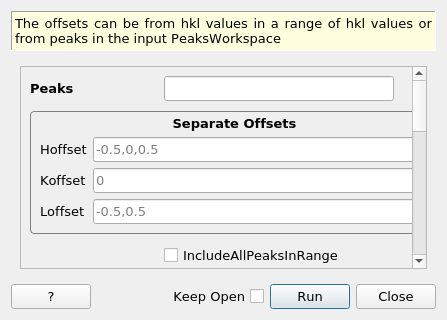\(\renewcommand\AA{\unicode{x212B}}\)
PredictFractionalPeaks v1¶

PredictFractionalPeaks dialog.¶
Summary¶
The offsets can be from hkl values in a range of hkl values or from peaks in the input PeaksWorkspace
See Also¶
Properties¶
Name |
Direction |
Type |
Default |
Description |
|---|---|---|---|---|
Peaks |
Input |
PeaksWorkspace |
Mandatory |
Workspace of Peaks with orientation matrix that indexed the peaks and instrument loaded |
Hoffset |
Input |
dbl list |
-0.5,0,0.5 |
Offset in the h direction |
Koffset |
Input |
dbl list |
0 |
Offset in the k direction |
Loffset |
Input |
dbl list |
-0.5,0.5 |
Offset in the h direction |
IncludeAllPeaksInRange |
Input |
boolean |
False |
If false only offsets from peaks from Peaks are used |
Hmin |
Input |
number |
-8 |
Minimum H value to use during search |
Hmax |
Input |
number |
8 |
Maximum H value to use during search |
Kmin |
Input |
number |
-8 |
Minimum K value to use during search |
Kmax |
Input |
number |
8 |
Maximum K value to use during search |
Lmin |
Input |
number |
-8 |
Minimum L value to use during search |
Lmax |
Input |
number |
8 |
Maximum L value to use during search |
ReflectionCondition |
Input |
string |
If provided, generate a list of possible peaks from this reflection condition and use them to predict the fractional peaks. This option requires a range of HKL values and implies IncludeAllPeaksInRange=true. Allowed values: [‘’, ‘Primitive’, ‘C-face centred’, ‘A-face centred’, ‘B-face centred’, ‘Body centred’, ‘All-face centred’, ‘Rhombohedrally centred, obverse’, ‘Rhombohedrally centred, reverse’, ‘Hexagonally centred, reverse’] |
|
RequirePeaksOnDetector |
Input |
boolean |
True |
If true then the predicted peaks are required to hit a detector pixel. Default=true |
ModVector1 |
Input |
dbl list |
0,0,0 |
Modulation Vector 1: dh, dk, dl |
ModVector2 |
Input |
dbl list |
0,0,0 |
Modulation Vector 2: dh, dk, dl |
ModVector3 |
Input |
dbl list |
0,0,0 |
Modulation Vector 3: dh, dk, dl |
MaxOrder |
Input |
number |
0 |
Maximum order to apply Modulation Vectors. Default = 0 |
CrossTerms |
Input |
boolean |
False |
Include combinations of modulation vectors in satellite search |
FracPeaks |
Output |
PeaksWorkspace |
Mandatory |
Workspace of Peaks with peaks with fractional h,k, and/or l values |
Description¶
This Algorithm creates a PeaksWorkspace with peaks occurring at specific fractional offsets from h,k,or l values.
There are options to create Peaks offset from peaks from the input PeaksWorkspace, or to create peaks offset from h,k, and l values in a range. Zero offsets are allowed if some or all integer h,k, or l values are desired
The input PeaksWorkspace must contain an orientation matrix and have been INDEXED by THIS MATRIX when the new peaks are not created from a range of h ,k, and l values
Usage¶
Example:
peaks = LoadIsawPeaks("TOPAZ_3007.peaks")
LoadIsawUB(peaks,"TOPAZ_3007.mat")
IndexPeaks(peaks)
fractional_peaks = PredictFractionalPeaks(peaks, HOffset=[-0.5,0,0.5],KOffset=0,LOffset=0.2)
print("Number of fractional peaks: {}".format(fractional_peaks.getNumberPeaks()))
Number of fractional peaks: 117
Categories: AlgorithmIndex | Crystal\Peaks
Source¶
C++ header: PredictFractionalPeaks.h
C++ source: PredictFractionalPeaks.cpp
